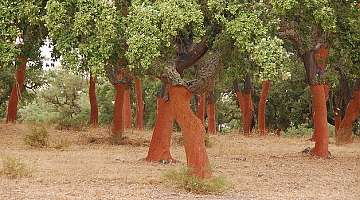The Victorious Cork of Portugal

Published on
Although the present economic situation in the world today can cause much alarm this has proven to be a non-issue for Portugal's cork industry. The indomitable cork industry has managed to successfully fight its way back and has even forged new ground around the world which has allowed it to recover lost strength. Even though Portugal's cork industry happens to enjoy a multi-million euro success the industry is nevertheless just as robust in discovering new markets while reaffirming its existing ones.
As the producer of about 60% of the cork supply in the world Portugal is assured of being the primary exporter of the product. Most bottles of wine and champagnes around the world boast corks produced by Portugal but nowadays one can find that this product is also utilized in construction, fashion and interior decoration.
Dr. Joaquim Lima, the general director of the Portuguese Association for Cork, APCOR, announced to The Portugal News that the industry recognizes increased demand internationally which proves to be reassuring signs of recovery.
He went on to say that 2011 is expected to be an even better year for the industry than 2010 was.
Portugal's cork is very popular when it comes for use with champagne and Dr. Lima said that all the champagne in the world makes use of the natural cork as stoppers and it is invariably Portuguese.
He also said that any well-known champagne brand in the world is quite probably using cork from Portugal.
Cork has also enjoyed a rise in popularity when it comes to fashionable accessories and Pelcor, a Portuguese company that manufactures these items has helped to boost the product and has demonstrated most effectively just how versatile the product actually is.
Pelcor was responsible for exhibiting a range of accessories in New York's MOMO Modern Art Museum in 2010.
Also in 2010, in June at the 2010 Expo exhibition which was hosted in Shanghai, China, many of the visitors were amazed by the Portuguese Pavilion because of its cork-covered walls.
The Cork Information Bureau compiles the most up-to-date figures and according to those figures which were then forwarded to The Portugal News by APCOR, 2010 saw a grand total of 156,198,218kg of cork exported with 93 million of those kilos going to the European Union.
What this means financially is that €754,330,278 was the total revenue which means that €446,998,474 was garnered from Portugal's EU counterparts.
Besides this the industry has also created many thousands of much needed jobs for many people.
Portugal's cork industry has around 700 companies that operate within it and together they manufacture around 40 million cork bottle stoppers each day of which 35 million are manufactured in the north of the country.
According to information supplied by the Ministry for Labor and Social Welfare the industry actually employs in excess of 10 thousand employees.
Among the 26 fellow EU state members the three top most importers of the country's cork are Germany, Spain and France. The fact that France is only the 3rd largest importer of Portuguese cork it is interesting to note that they spend the most on it.
Germany imported just over 27 million kilos, while Spain imported 15 million and it also spent more than Germany on the cork, paying over €78.5 million. Germany spent around €72.2 million. This difference is dependent largely upon whether the cork is sold naturally or has already been processed.
But France leads the import race having imported over 14 million kilos contributing more than €154 million toward the total revenue.
This is why Dr Lima affirmed that France is the country's most important market.
Interestingly between 2007 and 2010 the cork used for bottle stoppers actually declined by 4% while cork used in the field of construction, such as in paving, insulation and rendering, grew by 7%. This is a phenomenal occurrence and is heavily influenced by countries such as Germany.
The reason for this, according to Dr Lima, is because Germany uses the cork they import not only as wine stoppers but also in construction.
Germany considers cork to be a useful material when it comes to building and insulation but also has decorative purposes.
Market monitoring company AC Nielsen has discovered that countries like the US tend to prefer natural cork in place of other materials like plastic and aluminium. It also showed that when natural cork stoppers were utilized in the US's leading 100 wines sales actually increased by 14%. Wine bottles making use of other types of corks declined by 13%.
APCOR launched an international campaign and this has resulted in more advancement for the industry. It has demonstrated cork to be a favoured natural and sustainable product contrary to synthetic alternatives that are detrimental to the wellbeing of the planet.
APCOR's campaign is not confined solely to the US however, where it is known as 100% Cork, but also in other countries and is expected to continue until August, costing around €21 million.
The APCOR campaign, aptly called 100% Cork Campaign, was introduced at the site of the world famous Macy's superstore in New York City. Financed partly by APCOR and partly by Cork Quality Council it has proven to be one of the biggest ones of its kind to be carried out internationally in order to promote a product of Portuguese origin.
For information on buying property in Portugal contact the Portugal property team via email at: info@portugalproperty.com or call free on +44(0)800 014 8201
Published in: Portuguese Life